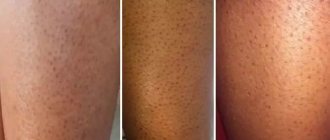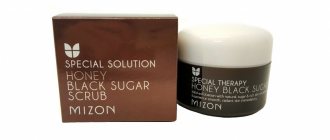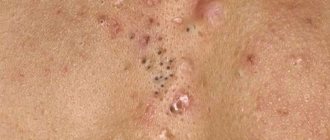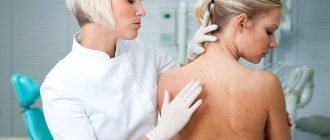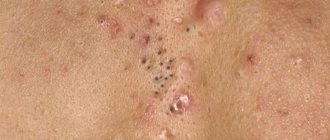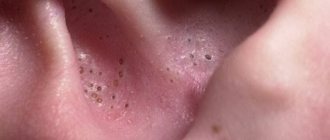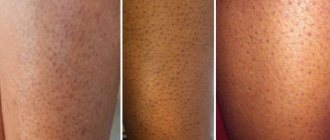05.02.2018
A gigantic number of pores are located comfortably on our skin - the excretory ducts of the sebaceous glands. As soon as they become clogged with dust, dirt and dead epithelial cells, blackheads and pimples form - the cause of complexes and aesthetic dissatisfaction, not only among adolescents suffering from increased efficiency of the sebaceous glands, but also among adults. Do you dream of getting rid of such a problem? I strongly recommend getting acquainted with cosmetics containing activated carbon. It is very effective against blackheads. Of course – a powerful absorbent and anti-inflammatory agent in one tablet! Such cosmetics can be bought ready-made or prepared independently at home.
Activated carbon for blackheads - wonderful properties of the product
The well-known absorbent visits our home medicine cabinets less and less often - it has been replaced by innovative achievements of pharmacists, which are actively advertised everywhere. But in vain, because this natural product is a unique, budget-friendly, effective means of cleansing the body of impurities, toxins and other harmful substances. Will charcoal help with blackheads? To answer this question, I suggest you familiarize yourself with the properties of the product:
- normalizes metabolic processes;
- regulates the activity of the sebaceous glands;
- has an anti-inflammatory, brightening and rejuvenating effect.
Activated carbon is an absorbent that draws out the “bleak” from the skin, taking it with it. According to eyewitnesses, it is able to cope even with contaminants that were beyond the power of mechanical facial cleansing.
You can find this wonderful product in cosmetics or use it yourself by preparing an effective mask for home use. Cleanse your skin with activated carbon 2 times a week, and the result will exceed all your expectations!
How does it affect the skin of the face?
Pharmaceutical charcoal is an absorbent of organic origin, used in medicine against intoxications of various etiologies. Its cleansing abilities are actively used by cosmetologists.
Tablets are used as the main component of home remedies for blackheads and spots. Its particles attract dirt molecules, dead cells, and sebaceous secretions. When removed, the mask pulls out impurities from the pores.
Effect of sorption properties of coal:
- cleanses, tightens pores;
- gets rid of unaesthetic blackheads;
- evens out complexion;
- reduces skin oiliness;
- soothes inflammation.
DIY film mask in just 1 minute
You've probably heard about the sensational black mask, which was actively advertised by manufacturers, show business stars and consumers themselves. The popularity of the product is justified by its pronounced effectiveness - impressive results are noticeable immediately after using the product!
However, not everyone can afford the price of this miracle remedy, and therefore particularly insightful beauties have come up with a worthy analogue of the black mask, which is easy to prepare at home. I present to your attention the simplest recipe for which you will need the following components:
- a tablespoon of gelatin;
- 2 tablets of activated carbon;
- water or milk.
It's simple - grind the coal to a powder, mix with gelatin and add a tablespoon of hot water (or heated milk). The mass should be thick, homogeneous, slightly warm. Leave it for 5 minutes, and then apply to problem areas (nose, chin, forehead, cheeks) and leave until the mixture completely hardens. We remove the resulting film and admire the results.
Attention: make sure that the mask does not get on your eyebrows - as it hardens, it pulls out not only blackheads, but also hairs.
Recipes
Homemade charcoal-based masks for blackheads are effective and easy to use. The ingredients are cheap and available at any pharmacy.
Need advice from an experienced doctor?
Get a doctor's consultation online. Ask your question right now.
Ask a free question
The properties of the composition help clean pores, absorb and remove toxins, bacteria, microbes that provoke inflammatory processes.
Charcoal acts on the deep layer of skin without injuring it; it is a safe natural product.
There are several effective mask recipes for treating blackheads.
With gelatin
A homemade film mask based on gelatin and black coal whitens, rejuvenates the skin, and cleanses pores.
The thin film that appears after applying the product works like a deep peeling. Sorbent particles draw out impurities from the deep layers of the skin; when removed, the frozen mixture captures the contents of the points - remnants of cosmetics, dust, excess sebum.
Other products - glycerin, starch, peroxide, oil extracts - can be supplemented with a homemade composition with charcoal, this has a beneficial effect on the skin.
Black mask ingredients:
- 1–2 tablets of coal;
- 1 incomplete teaspoon of edible gelatin;
- 1 tablespoon of water.
Dissolve gelatin in hot water. Grind the tablets into powder and mix with the base. Without allowing the homemade mask to cool, apply it to problem areas of the face with black greasy spots. When the film has hardened, pick it up by the edge and tear it off with a sharp movement. Dirt pulled out of the pores will be visible on the inside of the coating. After the procedure, wash your face with cool water or wipe your skin with an ice cube to tighten the pores.
If you replace water with milk, the skin after the mask will be cleansed and pleasant to the touch. Microelements of the dairy product soften the drying properties of coal.
If you have rosacea, it is better not to use a home remedy for spots: it can provoke a negative reaction and deterioration of the skin condition.
With water
Making a mask for blackheads at home from coal and water is a simple way to care for any skin type.
You need two ingredients:
- 3 tablets;
- 1 teaspoon of water.
Grind the tablets into powder and add water. The consistency of the mass should resemble thick sour cream.
Apply the composition, after drying, rinse off the residue with clean water. The result of the mask is noticeable after 2-3 home treatments: the face becomes lighter, the skin takes on a healthy appearance, an even tone, black sebaceous spots disappear, rashes, inflammation, and irritation go away. Instead of water, you can use a decoction of medicinal herbs with charcoal.
With soda
The effect of black pharmaceutical charcoal in a homemade mask is complemented by soda. Properties of sodium bicarbonate for fatty spots:
- exfoliates;
- reduces irritation;
- tightens pores;
- promotes cell regeneration;
- removes oily shine.
Homemade mask for acne, blackheads, and spots: mix baking soda and charcoal in equal proportions. Stirring constantly, add water to the dry ingredients until a thick paste forms. Apply to face with massage movements. Leave for 8–10 minutes. You can add essential oils to the main composition - 4-6 drops:
- Pink – for rejuvenation.
- Tea tree - for calming.
- Grape seeds - from flabbiness.
Baking soda is quite aggressive on the skin. Before using a black spot mask, test the reaction by applying a small amount of homemade charcoal mixture to the inside of your wrist.
With clay
For home cleaning of pores from sebaceous spots, mix activated carbon with black clay. The mask evens out complexion and regulates fat secretion.
To prepare you need:
- 1 tablet of coal;
- 1 tsp. black clay;
- 1 tsp. gelatin;
- 1 tsp. milk.
Pour milk over gelatin, heat until dissolved. Add clay and crushed coal tablet. When the homemade mixture becomes homogeneous and does not burn, lubricate the areas with spots and black comedones with the mixture. Leave the mask on for 15–20 minutes, rinse with warm water.
Scrub
To even out, cleanse, and smooth the skin, you can use a scrub mask with charcoal for dots.
Classic method of preparation: mix 10 tablets with 1 tbsp. l. fine sea salt. The resulting bulk composition is diluted using yogurt, sour cream, liquid honey, PVA glue or an egg in the amount of 1 tbsp. l.
Scrub your face with a homemade mixture step by step, from problem areas with spots to the neck and décolleté. There is no need to wash off the scrub immediately; it is left as a mask for 5-8 minutes for maximum impact.
There is no need to prepare a black scrub with charcoal in reserve. If there is more product than needed, add an aspirin tablet to the mixture and store it in the cold, in a tightly sealed container.
“Dirty” mask for blackheads and pimples
Mud masks have been known for their transformative properties since ancient times - they perfectly cleanse the skin, tone and brighten it, and have a healing effect. The most affordable and, most importantly, safe mud for the face is cosmetic clay, sold in pharmacies and regular stores.
To prepare an effective mask, take 1 tablet of charcoal and a teaspoon of clay of different colors - black, blue, white or green. The more types of mud you use, the better. Mix all ingredients, dilute with slightly warm water and apply the mixture to your face. The mixture will dry out quickly, which should not be allowed - moisten the skin with water using a spray or mist. After 15 minutes, wash off the mask.
Please note: if you don’t have gelatin or clay on hand, use the simplest recipe with activated carbon - even a crushed tablet diluted with plain water will help perfectly against blackheads.
Rules of application
To maximize the effectiveness of charcoal, skin with dots needs to be prepared for a homemade black mask: wash with cleansing gel, micellar water, foam. Then steam your face. Pour boiling water into a small container, sit over it for 5-10 minutes, covering your head with a towel. The procedure can be replaced with a hot bath or shower. Exposure to hot, humid air will open the pores, making the gland ducts more accessible to components.
Home control of cosmetic defects should be carried out according to the following rules:
- A charcoal mask for blackheads is applied to relaxed facial muscles. You cannot talk or smile during the procedure - the leftover mixture can form micro-creases in the epidermis.
- Formulations with gelatin should be warm. The cooled mixture cannot be distributed evenly over the face.
- Keep the home remedy for 10–20 minutes. You can remove the film after it has hardened, carefully picking it up by the edge.
- The course of manipulation lasts two months, then take a break for six months. You need to make a mask for spots once a week.
- Do not use the composition on inflammation, acne, acne, or other rashes.
- After home cleansing with black charcoal, use a rich cream or moisturizer to restore the skin's moisture balance.
Final advice
If blackheads are a consequence of the active activity of the sebaceous glands and are a permanent phenomenon, not a single mechanical cleaning by a cosmetologist will help you solve the problem forever. Be patient and carefully, and most importantly, regularly care for your skin using the products listed above - with each passing month the problem will bother you less and less. Remember, without meticulous care it will not be possible to maintain your face in impeccable condition.
Thank you for your attention! With best wishes, Vorobyova Nastya.
I like 73
How does activated carbon help?
The absorbent substance is highly active as a medicine that quickly absorbs poisons and relieves the body of intoxication.
Activated carbon can be found in various cleansers (gels, masks, scrubs, peelings, soaps and even shampoos). When using these products, the face takes on an unattractive appearance due to the dirty gray or black color of the compositions.
But this discomfort is worth enduring due to the high effectiveness of the product in the fight against blackheads and oily skin. Activated carbon literally absorbs all the dirt from open skin pores like a sponge.
Industrially produced compositions are easy to use and reduce the consequences of using the “black aggressor”, which, along with dirt, “sucks” useful elements out of the skin.
Indeed, these products, in addition to activated carbon, contain additional substances that immediately during the procedure replenish the “devastation” of the epidermis. It is advisable to use products from well-known brands.
The disadvantage of store-bought products is their high price compared to the cheap cost of activated carbon itself.
But homemade masks for blackheads with this component are not inferior in effectiveness to purchased analogues, but are affordable and allow you to carry out a full course of treatment without harming your wallet.
Recommendations for the use of activated carbon masks
The result will be more pronounced if you follow the rules for making and using masks:
- Thoroughly clean the area of application from cosmetics and dirt.
- Warm up the skin in any convenient way. A hot towel, shower or steam exposure will do.
- Grind the charcoal to a powder consistency. Large particles can damage the skin. Also, the quality of the mask will be lower due to its non-uniform consistency.
- Apply in courses. It is enough to do one mask a week for 1-1.5 months for the skin to transform. The break between courses lasts a month.
- Avoid the area around the eyes.
- Be sure to moisturize your skin after the procedure. Otherwise, dehydration may occur.
- A common mistake is using charcoal masks immediately after cleansing your skin. As a result, particles can become clogged in the pores, leading to inflammation. Therefore, it is better to carry out the procedure when the epidermis has recovered.
Alternative ways to use activated carbon in facial skin care
The use of activated carbon in cosmetology is not limited to masks. Based on this component, you can prepare cosmetic ice, scrub and even soap.
Ice cubes
Used for daily wiping of the skin. An alternative or complement to your primary tonic.
- Crush 1 tablet of charcoal.
- Pour the powder into a glass of warm water.
- Pour into molds and freeze.
Scrubs
Homemade scrubs based on activated carbon deeply cleanse pores and remove blackheads. They also have an exfoliating effect. Apply once every two weeks.
First option:
- Grind 10 charcoal tablets.
- Dilute with water. The mixture should be thick.
- Distribute over damp skin and massage.
- Keep it on for 10 minutes as a mask.
Second option:
- Crush 10 charcoal tablets.
- Add 1 small spoon of white clay.
- Dilute with water, milk or rose water.
- Apply to damp skin and scrub.
- Leave for 15 minutes.
Third option:
- Grind 10 charcoal tablets.
- Add ½ small spoon of finely ground sea salt.
- Mix with 1 large spoon of natural yogurt or kefir.
- Add 1 small spoon of lemon juice.
- Massage into damp skin.
- Leave for 10 minutes.
Soap
You don't have to make homemade activated carbon soap from scratch. You will need regular baby soap and a pack of coal.
- Crush 10 tablets of activated carbon.
- Take a bar of new soap. Divide into pieces or finely grate.
- Melt in a water bath. Stir occasionally with a wooden spatula.
- Add powder to melted soap and stir.
- Pour into a mold and leave to harden.
Important! The microwave is not suitable for melting soap. Firstly, it is difficult to control the process. Secondly, you can ruin your household appliance because the smell of the detergent lingers.
How to get rid of blackheads on the face - the opinion of a cosmetologist
Source: "DoctorPeter" Date: 06/01/2021
It would seem that adolescence is behind us, but many people still have black spots. Both men and women have this problem. How to deal with it, advises a dermatologist and cosmetologist at the St. Petersburg City KVD.
The most common reason for the appearance of black spots on the skin, especially on the nose, is a change in hormonal levels or increased sensitivity of the sebaceous gland receptors to the normal level of sex hormones, which is why sebum begins to be actively produced, explains the dermatologist, cosmetologist, head of the department of the St. Petersburg City Dermatovenerological dispensary Elena Moshkova.
“But in order for blackheads to form, there must also be predisposing factors: poor exfoliation of the skin and a change in the viscosity of the skin secretion (sebum),” explains the doctor. - In addition, black spots can be a sign of skin elastosis, which mainly manifests itself in old age. Skin elastosis is a sign of photoaging, so to preserve youthful skin, cosmetologists warn against excessive tanning.
And yet, why are these dots black?
Melanin, which is formed in sebum due to the oxidation of the amino acid tyrosine, is responsible for the black color.
— Black dots themselves, for example, on the nose, are not a marker of some painful condition, but may be a variant of the norm for a certain skin type. Let me remind you that skin type is inherited,” notes Elena Moshkova.
But if you decide that you can fight blackheads by trying to normalize your inherited oily skin, then you will make a mistake.
“There is no need to try to “transform” skin into another type with skincare products, for example, oily to normal,” says the dermatologist at GorKVD. - The fact is that you will need aggressive products, and as a result, your skin type will still remain your own, but other problems will appear - for example, dehydration. It is more correct to use adapted gentle products that are suitable specifically for your skin type.
How to remove blackheads on face
First of all, to remove unsightly blackheads, you need to cleanse your facial skin, the cosmetologist advises. And to prevent their occurrence, use creams containing acids (for example, azelaic acid) and gommages (cleaning and exfoliating products). Their difference from scrubs is that gommage does not contain solid abrasive particles. It cleanses the skin more carefully and at the same time takes care of it.
Chemical peels are also recommended for skin prone to blackheads. Nowadays, cosmetics manufacturers also produce all-season peels that can be used in the summer.
“It is possible to use external products based on vitamin A,” advises Elena Moshkova. - However, we must remember that they are used with caution in the summer and they are strictly prohibited for pregnant women and during pregnancy planning. The skincare product must be marked as non-comedogenic (comedogenicity is a characteristic of cosmetic products that determines their ability to cause the formation of comedones (blackheads), that is, in one way or another to contaminate and clog skin pores).
The dermatologist notes that in the summer, in the active sun, the risk of blackheads on the face may increase.
“Don’t forget about sun protection, you must use sunscreen, since ultraviolet radiation provokes hyperkeratosis - excessive thickening of the stratum corneum of the epidermis, excessive keratinization of the skin, which in turn aggravates the problem of blackheads and comedones,” sums up the dermatologist.
Anna Maiskaya
Indications and contraindications
It is recommended to make masks based on activated carbon if you are prone to the appearance of imperfections:
- acne, pimples, comedones;
- enlarged pores;
- clogged pores;
- greasy shine;
- pigmentation;
- skin aging;
- small wrinkles.
However, masks with this sorbent are not suitable for everyone. You should avoid using it in several cases:
- the presence of open wounds, injuries and other skin disorders;
- purulent elements;
- ulcers;
- bleeding in the area of application;
- individual intolerance to the drug.
Important Limitations
Before cooking, read the rules that must be followed so as not to harm your skin.
- Do not use expired ingredients!
- The mask should be prepared in a glass container (exclude plastic and metal).
- Before applying the mask, clean your face of makeup. Steam your face by taking a bath or applying a hot compress to your face.
- Do not bring the mask to a boil.
- Do not apply the mask in a thick layer - this will take longer to dry and will tighten the skin. It's better to apply 2-3 thin layers.
- Do not use a mask under or around the eyes.
- Do not keep the mask on for more than 25 minutes.
- Don't rub your face with a hard towel! It is better to pat your face dry after washing.
- Use moisturizer after rinsing off!
- This mask should be used no more than once a week.
- Do not use the mask if you have sores or cuts on your face.
It is better to carry out the procedures in courses, no longer than 1.5 months and no more than twice a week. Then you need to take a break for 4-6 weeks to restore the skin.
Why traditional medicine?
The cosmetology industry is developing rapidly; every year, dozens of manufacturers replenish the market with a variety of products, trying to guess people’s wishes. Their products are made using modern equipment, have passed dozens of tests, and, judging by the advertising, have special active particles that can remove all excess from the face, leaving a fresh and natural look. Why is homemade mask for blackheads so popular?
It can be easily made at home, there are dozens of recipes from traditional medicine and the ingredients for such a mask can be found in any home, as user reviews say;- A homemade mask is completely natural; now you can’t rely on advertising promising natural purchased products. Study the composition of any store-bought products, especially cosmetics. A dozen unfamiliar names, obviously chemistry. Perhaps such a nuclear composition will help with acne or blackheads, but who knows what price the skin will have to pay for such help? How will the active particles work? Moreover, allergy sufferers should be wary of this;
- Treatment can be done at home, without going to salons and without the help of cosmetologists. This saves a lot of money, because most specialists will prescribe a course of treatment. You will have to shell out the cost of each visit, but a mask made at home for blackheads is affordable and, according to reviews, useful and completely safe. After all, its composition is completely known;
- Of course, there are no guarantees of unconditional help from a homemade mask, but is it worth a try? Most of the ingredients, if they don’t get rid of annoying blackheads, at least provide the skin with beneficial elements.
The effect of charcoal masks
The idea of using activated carbon for cosmetic purposes appeared because this substance retains the properties of natural wood even after the entire technological processing process, and transfers them to the mixtures in which it is included. The chemical composition of coal includes only three elements:
- hydrocarbon (C);
- oxygen (O);
- hydrogen (H).
But “in tandem,” these chemicals are capable of “arranging a mini-revolution” in cells, streamlining metabolic processes in them, and cleansing the epidermis of various types of contaminants.
Here's how a charcoal mask affects your facial skin:
- It affects the functioning of the glands in such a way that the production of subcutaneous sebum decreases, therefore the formation of sebaceous plugs, from which comedones, blackheads, and pimples subsequently appear, stops. The result is the absence of greasy shine and improvement in the condition of oily skin.
- Removes blackheads and prevents their appearance in the future. It even gets rid of small acne that cannot be removed by other means.
- Stops inflammatory processes in the form of pimples and acne even in teenage users. Heals pimples, reduces their spread across the face, and prevents their subsequent appearance.
- Smoothes the skin texture and eliminates small wrinkles.
- Gives the face an even, healthy shade, eliminates yellowness and pallor (not caused by serious diseases of the internal organs).
- Deeply cleanses pores of all impurities and toxins.
- Provides skin cells with freedom to breathe.
Facial cleansing with activated carbon at home is highly effective and stable results, which will not disappear a couple of hours after the procedure (as happens when using other products). A homemade black mask can be made at any age. But there are contraindications for using this product:
- excessively dry and sensitive skin;
- rosacea accompanied by spider veins;
- allergy to the components of the mask;
- wounds, ulcers, fresh scars, ulcers, bleeding on the face.
Tangible improvements occur after the first procedure, but it is worth considering that the skin will become beautiful and radiant only after regular use of the mask and additional cosmetics.
Preparing facial skin for the procedure
To get the best results from using a charcoal mask, you need to prepare your skin before the procedure. Otherwise, the effect of the medicinal mixture will be superficial, and deep cleansing will not work.
Simple manipulations will help open the pores of the skin and make it easier for the coal particles to work. Here's what to do:
- Tie back hair with plastic tape.
- Remove makeup with micellar water or cosmetic milk.
- Wash with foam or soap.
- Steam your skin. If you don't have a special bath, hold your face over a bowl of very hot water, covered with a towel. You can add a couple of drops of your favorite aromatic oil to the water or use chamomile infusion.
- Delicate skin can be steamed in a gentle way (using a hot, damp towel dipped in fresh chamomile infusion).
At the preparatory stage (before steaming), light peeling will not hurt.
As a result of removing the upper coarsened layer of the epidermis, coal particles will be able to penetrate deeper into the skin, their effect will be more noticeable, and the result of the procedure will be more stable. For delicate sensitive skin, peeling before a black mask should not be done.
In addition to preparation before applying the mask, finishing procedures are also important. After all, the skin requires antiseptic treatment and nutrition. Therefore, after removing the composition with coal, it does not hurt to perform the following steps:
- Irrigation of the face with an infusion of medicinal herbs (St. John's wort, sage, calendula, etc.).
- Rubbing the skin with ice cubes or rinsing with cold water.
- Application of nourishing cream (after the disappearance of skin redness).
If your face remains red for a long time after removing the blackhead remedy, this means that mistakes were made when preparing the mixture with charcoal, carrying out the procedure, or your skin is too sensitive. In any case, redness does not pose a great danger (it will soon go away).
